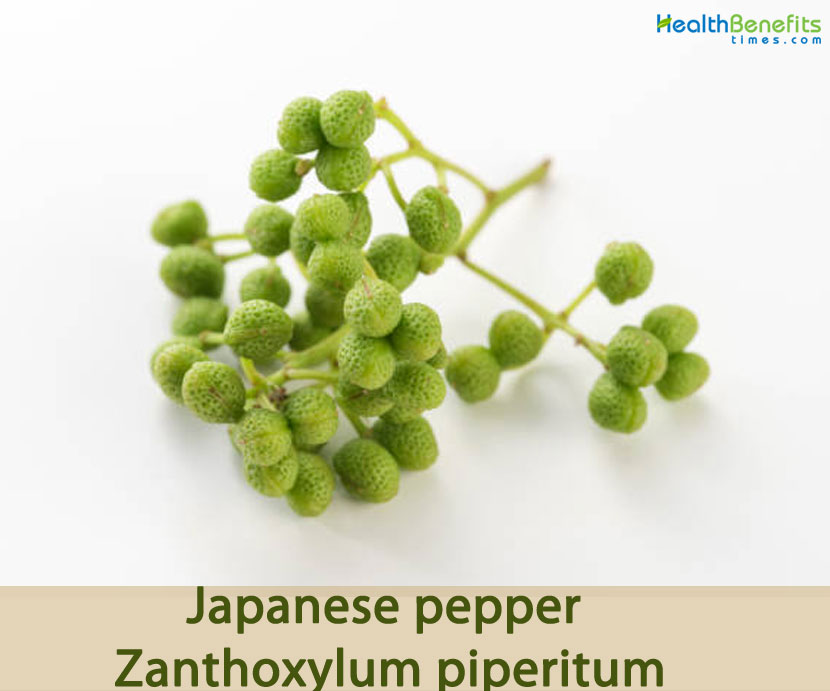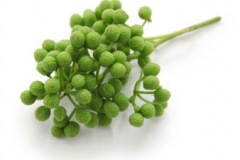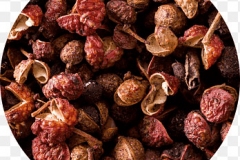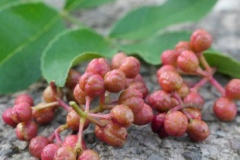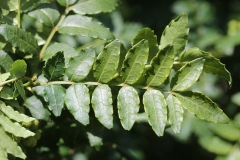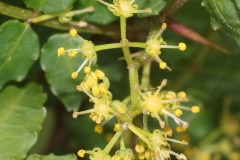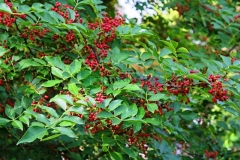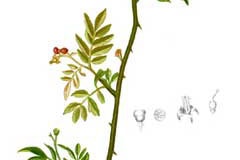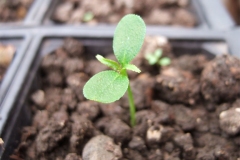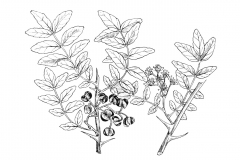Japanese Pepper Facts
| Japanese pepper Quick Facts | |
|---|---|
| Name: | Japanese pepper |
| Scientific Name: | Zanthoxylum piperitum |
| Origin | China, Japan, Korea and also in other countries such as Nepal, Tibet, Bhutan and Japan |
| Colors | Reddish |
| Shapes | Berries or peppercorns of about 5 mm that contain black seeds |
| Taste | Bitter, Acrid, Pungent |
| Health benefits | Beneficial for tuberculosis, dyspepsia, internal parasites, asthma, kidney and bladder complaints, edema, dysentery, ecchymosis, lactorrhea, malaria, polyuria and spermatorrhea |
| Name | Japanese pepper |
|---|---|
| Scientific Name | Zanthoxylum piperitum |
| Native | China, Japan, Korea and also in other countries such as Nepal, Tibet, Bhutan and Japan |
| Common Names | Japan Pepper, Poivrier De Sichuan, Clavalier, Fagara, Sansho, Poivrier Du Japon, Szetchwan pepper, Anise pepper, Spice pepper, Sichuan pepper, Chinese pepper, Japanese pepper, (Japanese) prickly ash, Indonesian lemon pepper, Szechuan-Pfeffer, Chinesischer Pfeffer, Japanischer Pfeffer, Blütenpfeffer, Bergpfeffer, Gelbholzbaum, Anispfeffer, Indonesischer Zitronenpfeffer, sanshou, Chin chiao, Chopinamu, Chop’inamu, Faah jiu, Fagara, Hu chiao, Hua chiao, Hua jiao, Japanischer Pfeffer, Pepper Ash, Sansho |
| Name in Other Languages | Chinese: Hua jiao (花椒), Shan jiao (山椒), Shan hua jiao (山花椒 ), Le Dang Hua Jiao Czech: Čínský pepř, Japonský pepř, Pepř sečuánský, Sanšó Dutch: Japanse peperboom English: Japanese pepper, Japanese-pepper tree, Szechwan pepper, Korean pepper, chopi, Japanese prickly ash Estonian: Pipra-koldpuu Finnish: Pippurilimopuu French: Clavalier, Clavalier poivrier, Poivre anisé, Poivre brun, Poivre de Szechuan, Poivre du Setchuan, Poivre du Sichuan, Poivrier du Japon, Poivre rouge, poivre fleur German: Anispfeffer, Chinesischer Pfeffer, Gelbholzbaum, Japanischer Pfeffer, Szechuan-Pfeffer, Pfefferbaum, Japanischer, japanischer Gelbholzbaum, japanischer Pfefferbaum Hindi: Tephal, Tirphal, timbur Hungarian: Ánizsbors, Kínai bors, Szecsuáni bors, Italian: Pepe d’anis Japanese: Kinome (キノメ), Kinome (きのめ), Sanshō no ha (山椒の葉 ) , Sanshou (サンショウ) Korean: Cho pi na mu (초피나무), chopi (초피) Marathi: Tiraphaḷa (तिरफळ) Persian: فلفل ژاپنی Polish: Pieprz chiński, Pieprz japoński, Pieprz syczuański, Żółtodrzew, Sanshō Portuguese: Fagara, pimenta-do-japão, pimenteira-do-japão Russian: Yaponskiy perets (Японский перец) Iaponskii perets, Sychuan’skii perets (Сычуаньский перец), zheltodrevesnik perechnyy (желтодревесник перечный), perechnoye derevo (перечное дерево) Spanish: Cayatuna, Pimienta de anis, Pimienta del Japón, pimentero japonés Vietnamese: Hoàng lực, Sưng, Trưng, Xuyên tiêu |
| Plant Growth Habit | Compact, rounded, deciduous aromatic spiny shrub or small tree |
| Plant Size | 8-15 ft. (2.5-4.5 m) tall and wide |
| Leaf | Leaves are alternate, pinnately compound, from 7.5-15 cm long, with eleven to twenty-three leaflets, the main-stalk downy, having a few small spines on the lower side, and slightly winged |
| Flowering season | April to June |
| Flower | Flower yellow-green, small, in 2.5-5 cm clusters. It is dioecious, and the flowers of the male plant can be consumed as hana-sanshō, while the female flowers yield berries or peppercorns of about 5 mm. |
| Fruit Shape & Size | Berries or peppercorns of about 5 mm that contain black seeds which are ground and used as a seasoning in Japan |
| Fruit Color | Reddish |
| Seed | Seeds are black, about the size of large shot |
| Taste | Bitter, Acrid, Pungent |
| Plant Parts Used | Bark, Seed, Leaves, Fruits |
| Season | October till November |
| Precautions |
|
Plant Description
Japanese pepper is a compact, rounded, deciduous aromatic spiny shrub or small tree that normally grows about 8-15 ft. (2.5-4.5 m) tall and wide. Leaves are alternate, pinnately compound, from 7.5-15 cm long, with eleven to twenty-three leaflets, the main-stalk downy, having a few small spines on the lower side, and slightly winged. Leaflets are 2-4 cm long, ovate, stalk less, toothed, with an occasional prickle on the midrib which is also downy above, dark green, but often yellow in the center when young. The backside is whitish by comparison to the top side.
Flower & Fruit
The tree blooms in April to May, forming axillary flower clusters, about 2.5-5 cm, and yellow-green in color. It is dioecious, and the flowers of the male plant can be consumed as hana-sanshō, while the female flowers yield berries or peppercorns of about 5 mm. In autumn, these berries ripen, turning scarlet and burst, scattering the black seeds within. These black seeds are ground and used as a seasoning in Japan.
Health benefits of Japanese pepper
Japanese pepper is a great condiment and has a lot to give for health. Listed below are some of the well-known health benefits of Japanese pepper
1. Good for Eye Health
Vitamin A helps to protect your eyes from night blindness and/or any age related weakening. It may lower the risk of certain types of cancers. Amazingly, it reduces or minimizes the risk of acne. It supports normal vision, cell growth and your immune system.
2. Contains lots of B vitamins
Japanese pepper consists of B Vitamins which are beneficial to the body. It is vital in boosting the immune system, breaks down food to energy and encourages healthy hormones. It also prevents diseases such as beri-beri, and reduces risks in heart diseases. Studies show that Japanese pepper also contains Vitamin B12, a vitamin that can help you avoid anemia. Moreover, it contains vitamin B9 (folic acid) which is essential for pregnancy and for growing a healthy baby.
3. Strengthens the bones
This incredible pepper has calcium which helps build and maintain strong bones. Calcium is needed for better functioning of your heart, muscles, and nerves. Moreover, Japanese pepper may help in slow bone mineralization which in effect, reduces risks of fractures in the bones.
4. Treatment for diarrhea
Japanese pepper was known before as naruhajika and was used traditionally as a remedy for diarrhea since the Heian Period. In fact, it was considered as a best treatment for many digestive problems. It helps in normalizing your bowel movements and supports your intestines in absorbing fluids. If you want an easy home remedy found in the kitchen, you better try Japanese pepper at your home.
Traditional uses and benefits of Japanese pepper
- It is antiperiodic, antitussive, carminative, diuretic, parasiticide and stimulant.
- Fruit consists of an essential oil, flavonoids and isoquinoline alkaloids.
- It is anthelmintic, antibacterial, antifungal and stomachic.
- It prevents the synthesis of prostaglandin and, in larger doses, is toxic to the central nervous system.
- It is used in Korea in the treatment of tuberculosis, dyspepsis and internal parasites.
- Resin contained in the bark, and especially in roots, is powerful stimulant and tonic.
- Fruit pericarp has been used as an anthelmintic and for treating disorders of the digestive organs in Korea.
- Decoction of the root is used in the treatment of snakebites.
- Bark was extensively used for toothache, colic, and rheumatism.
- It is recommended in the treatment of dysentery, spermatorrhcea, galactorrhoea, and polyuria.
- Externally, it is used as a stimulant to the skin and as a parasiticide.
- Seeds are considered diuretic, and are used in the treatment of dropsies, diseases of the kidney and bladder, and in asthma.
- Decoction of the root is used in the treatment of kidney and bladder difficulties.
- It is used as a wash; the decoction is used to treat ecchymosis and other skin affections.
- Ethno botanical uses of Japanese pepper include the treatment of tuberculosis, dyspepsia (indigestion), internal parasites, asthma, kidney and bladder complaints, edema, dysentery, ecchymosis, lactorrhea, malaria and polyuria.
- It prevents the skin from damage caused by free radicals. It slows down the effect of free radicals on the Skin. It slows down the Aging process. It promotes cell regrowth. It makes skin beautiful and radiant.
- It inhibits the synthesis of Prostaglandin in the body.
- Japanese Pepper is used as a remedy for digestive and Intestinal problems.
- It is helpful in burning body fat.
- It helps to digest food and burn fat in the body.
- In China, Japanese pepper has historically been used as an antiseptic and as a digestive aid that was thought to benefit the spleen and stomach.
- The spicy, warming herb was also used for intestinal parasites, colds, fevers, and as an anti-fungal.
- In Korea, the berries are used in temple food dishes, referring to vegetarian meals that are served in Buddhist temples, which aid meditative practices.
- It’s used for stomach ache and abdominal fullness and used mainly for gastric disorders.
Culinary Uses
- Ground-up seeds are used as a pepper substitute whilst the bark and leaves are used as a spice.
- Pulverized berries are the standard spice for sprinkling on broiled eel (kabayaki-unagi) and is one of the main ingredients of the blended spice called shichimi.
- Seed is ground into a powder and used as a condiment, a pepper substitute.
- It is often heated in order to bring out its full flavor and can be mixed with salt for use as a table condiment.
- Ground and dry-roasted fruit is an ingredient of the Chinese five spice powder.
- Bark and leaves are used as a spice.
- Young leaves can be consumed raw or cooked.
- They are used in soups or as a flavoring in salads.
- Both the leaves and fruits (peppercorns) are used as an aromatic and flavoring in these countries.
- Young leaves and shoots are often garnished grilled fish and soups.
- The young leaves are crushed and blended with miso using suribachi to make a paste, a pesto sauce of sorts, and then used to make various aemono (tossed salad).
- Immature green berries are blanched and salted, or simmered using soy sauce into dark-brown tsukudani, which is eaten as condiment.
- Berries are also cooked with small fry fish and flavored with soy sauce, a specialty item of Kyoto.
- In Southern Korean cuisine, dried and ground chopi fruit is used as a condiment served with varieties of food, such as chueo-tang (loach soup), maeun-tang (spicy fish stew), and hoe (raw fish).
- Leaves are also eaten pickled as jangajji, pan-fried to make buchimgae (pancake), or deep-fried as fritters such as twigak and bugak.
- Chopi leaves are added to anchovy-salt mixture to make herbed fish sauce, called chopi-aekjeot.
- Young leaves are used as a flavoring in salads.
Other Facts
- The trees can start fruiting when they are 2-3 years old.
- Thick wood of the tree is traditionally made into a gnarled and rough-hewn wooden pestle, to use with suribachi in Japan.
- While sansho wood surikogi are less common today, they impart subtle flavor to foods ground with them.
- In Southern parts of Korea, the fruit is traditionally used in fishing.
- Being poisonous to small fish, a few fruit dropped in a pond make the fish float shortly after.
- In Japan, Sansho found favor as a cooking ingredient that could help remove strong odors from food, such as fish dishes.
References:
https://npgsweb.ars-grin.gov/gringlobal/taxon/taxonomydetail?id=42197
https://pfaf.org/user/plant.aspx?LatinName=Zanthoxylum+piperitum
https://www.cabi.org/isc/datasheet/57359
https://landscapeplants.oregonstate.edu/plants/zanthoxylum-piperitum
https://en.wikipedia.org/wiki/Zanthoxylum_piperitum
http://www.theplantlist.org/tpl1.1/record/kew-2469335
https://gd.eppo.int/taxon/ZANPI
https://davesgarden.com/guides/pf/go/2210/#b
https://temperate.theferns.info/plant/Zanthoxylum+piperitum


